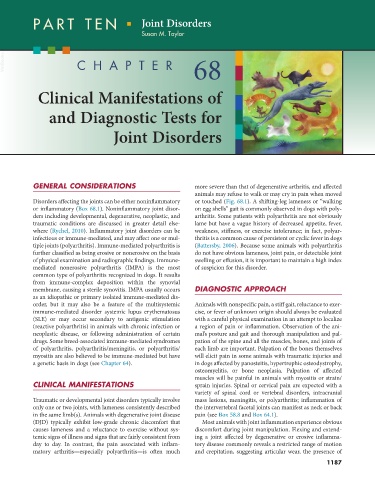Page 1215 - Small Animal Internal Medicine, 6th Edition
P. 1215
PART TEN Joint Disorders
Susan M. Taylor
VetBooks.ir CHAPTER 68
Clinical Manifestations of
and Diagnostic Tests for
Joint Disorders
GENERAL CONSIDERATIONS more severe than that of degenerative arthritis, and affected
animals may refuse to walk or may cry in pain when moved
Disorders affecting the joints can be either noninflammatory or touched (Fig. 68.1). A shifting-leg lameness or “walking
or inflammatory (Box 68.1). Noninflammatory joint disor- on egg shells” gait is commonly observed in dogs with poly-
ders including developmental, degenerative, neoplastic, and arthritis. Some patients with polyarthritis are not obviously
traumatic conditions are discussed in greater detail else- lame but have a vague history of decreased appetite, fever,
where (Rychel, 2010). Inflammatory joint disorders can be weakness, stiffness, or exercise intolerance; in fact, polyar-
infectious or immune-mediated, and may affect one or mul- thritis is a common cause of persistent or cyclic fever in dogs
tiple joints (polyarthritis). Immune-mediated polyarthritis is (Battersby, 2006). Because some animals with polyarthritis
further classified as being erosive or nonerosive on the basis do not have obvious lameness, joint pain, or detectable joint
of physical examination and radiographic findings. Immune- swelling or effusion, it is important to maintain a high index
mediated nonerosive polyarthritis (IMPA) is the most of suspicion for this disorder.
common type of polyarthritis recognized in dogs. It results
from immune-complex deposition within the synovial
membrane, causing a sterile synovitis. IMPA usually occurs DIAGNOSTIC APPROACH
as an idiopathic or primary isolated immune-mediated dis-
order, but it may also be a feature of the multisystemic Animals with nonspecific pain, a stiff gait, reluctance to exer-
immune-mediated disorder systemic lupus erythematosus cise, or fever of unknown origin should always be evaluated
(SLE) or may occur secondary to antigenic stimulation with a careful physical examination in an attempt to localize
(reactive polyarthritis) in animals with chronic infection or a region of pain or inflammation. Observation of the ani-
neoplastic disease, or following administration of certain mal’s posture and gait and thorough manipulation and pal-
drugs. Some breed-associated immune-mediated syndromes pation of the spine and all the muscles, bones, and joints of
of polyarthritis, polyarthritis/meningitis, or polyarthritis/ each limb are important. Palpation of the bones themselves
myositis are also believed to be immune-mediated but have will elicit pain in some animals with traumatic injuries and
a genetic basis in dogs (see Chapter 64). in dogs affected by panosteitis, hypertrophic osteodystrophy,
osteomyelitis, or bone neoplasia. Palpation of affected
muscles will be painful in animals with myositis or strain/
CLINICAL MANIFESTATIONS sprain injuries. Spinal or cervical pain are expected with a
variety of spinal cord or vertebral disorders, intracranial
Traumatic or developmental joint disorders typically involve mass lesions, meningitis, or polyarthritis; inflammation of
only one or two joints, with lameness consistently described the intervertebral facetal joints can manifest as neck or back
in the same limb(s). Animals with degenerative joint disease pain (see Box 58.8 and Box 64.1).
(DJD) typically exhibit low-grade chronic discomfort that Most animals with joint inflammation experience obvious
causes lameness and a reluctance to exercise without sys- discomfort during joint manipulation. Flexing and extend-
temic signs of illness and signs that are fairly consistent from ing a joint affected by degenerative or erosive inflamma-
day to day. In contrast, the pain associated with inflam- tory disease commonly reveals a restricted range of motion
matory arthritis—especially polyarthritis—is often much and crepitation, suggesting articular wear, the presence of
1187

